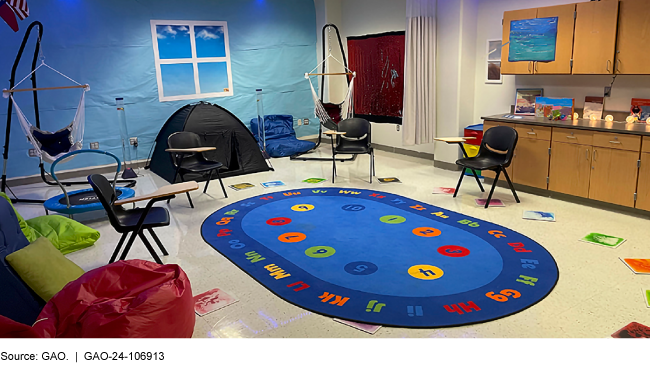K-12 Education: School Districts Reported Spending Initial COVID Relief Funds on Meeting Students' Needs and Continuing School Operations
Fast Facts
School districts had spent about $60 billion in federal COVID emergency relief funds by the end of the 2021-2022 school year.
About 80% of this money was used to address students' needs—such as providing summer school and tutoring to help get kids back on track—and to keep schools running. The remaining 20% went to addressing physical and mental health concerns, including improving ventilation and hiring school psychologists.
Districts we visited are using data to examine the effectiveness of their efforts. They are also looking into the availability of other funding to decide if they can sustain their efforts after the COVID funding runs out.
Example of how a school district used this funding to staff and furnish "reset centers" to help students manage their behavior

Highlights
What GAO Found
School districts nationally reported spending a combined total of nearly $60 billion in Elementary and Secondary School Emergency Relief (ESSER) funds through school year 2021–22, according to GAO's analysis of the Department of Education's (Education) data. About 80 percent of ESSER spending through school year 2021–22 went to addressing students' academic, social, and emotional needs and continuing school operations. For example, most of the districts GAO visited added instructional time and many purchased new curricula. The remaining 20 percent went to addressing physical and mental health concerns, including purchasing cleaning supplies, improving ventilation, and hiring school psychologists.
School Districts' Reported Use of K-12 COVID Relief Funds for Activities to Maintain Safe, In-Person Instruction, School Year 2021–22

Note: Percentages do not add to 100 percent because school districts could use funds for multiple activities.
Multiple national, state, and district level factors influenced ESSER spending decisions in the 17 school districts across six states GAO visited. For example, the amount of ESSER funds received was a key factor in prioritizing spending for these districts. For some, that meant being able to take care of basic needs while avoiding funding deficits. For others, it meant moving beyond basic needs to making capital improvements or implementing new activities. State officials described their processes for screening and approving districts' proposed uses of ESSER funds. They said they approved proposed activities that demonstrated clear linkage to COVID-related issues. States sometimes differed on what activities they considered allowable under ESSER. Ten of the districts relied on a specific philosophy to guide and prioritize their ESSER spending. For example, one district developed broad pandemic-related goals such as addressing learning loss and ensuring a safe return to school.
Officials from 16 districts said they used various data to examine ESSER-funded activities. However, pinpointing the effectiveness of any one individual activity may be difficult because, for example, districts initiated multiple activities during the pandemic. Further, not enough time has passed to know if any initial positive effects will remain long-term. Most district officials also said they began making decisions about whether to sustain, scale, or sunset ESSER-funded activities well before the funding ended. Factors included program results and access to other sources of funding. State officials said they also encouraged school districts to avoid spending that could not be sustained after ESSER funds ended.
Why GAO Did This Study
The COVID-19 pandemic caused widespread closures and disruption for K-12 schools nationwide. To help address issues related to COVID-19, Congress appropriated nearly $190 billion in ESSER funds, the vast majority of which went to school districts. School districts could generally use ESSER funds for a broad range of purposes designed to prevent, prepare for, or respond to the pandemic (e.g., addressing learning loss or facilitating a safe return to in-person instruction).
GAO was asked to review how school districts used their ESSER funds. This report addresses (1) how the nation's school districts spent ESSER funds, (2) factors selected districts considered when prioritizing spending, and (3) how selected districts gauge the effects of their spending and how they are planning for the end of ESSER funding.
GAO analyzed Education's ESSER spending data for school years 2020–21 and 2021–22 (most recent data available) nationally and by district characteristics. GAO also conducted site visits to 17 school districts across California, Florida, Michigan, New York, Pennsylvania, and Texas to provide illustrative examples of state and district decision-making regarding ESSER spending. These six states collectively received more than 40 percent of all ESSER funds. GAO selected school districts for variety in urbanicity, enrollment, total ESSER funds received, and student demographics. GAO also reviewed relevant reports from and conducted interviews with Education and national organizations actively monitoring ESSER spending.
For more information, contact Jacqueline M. Nowicki at (202) 512-7215 or nowickij@gao.gov.
